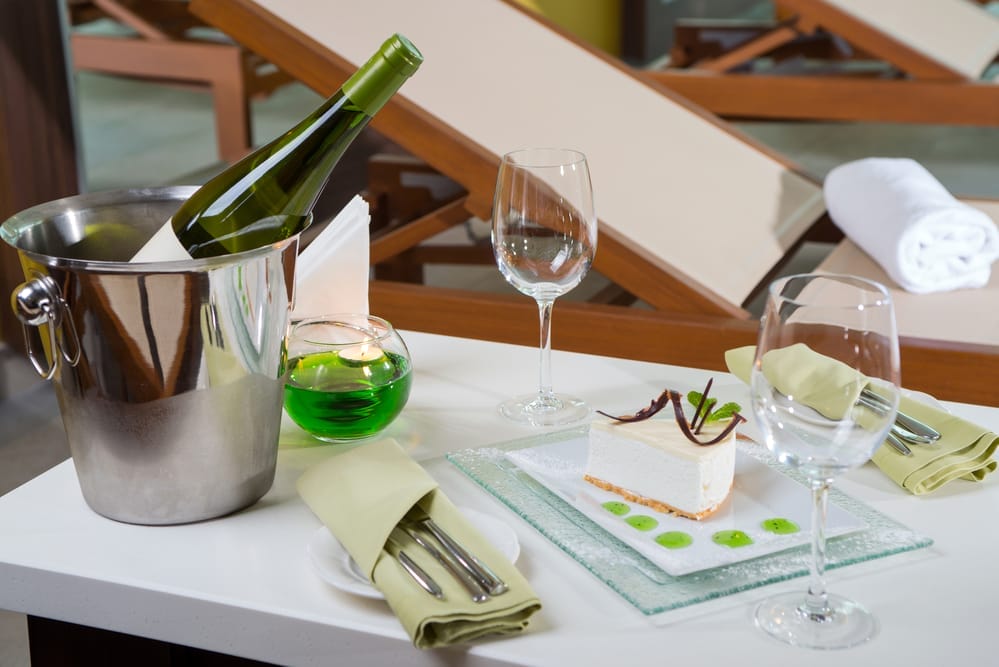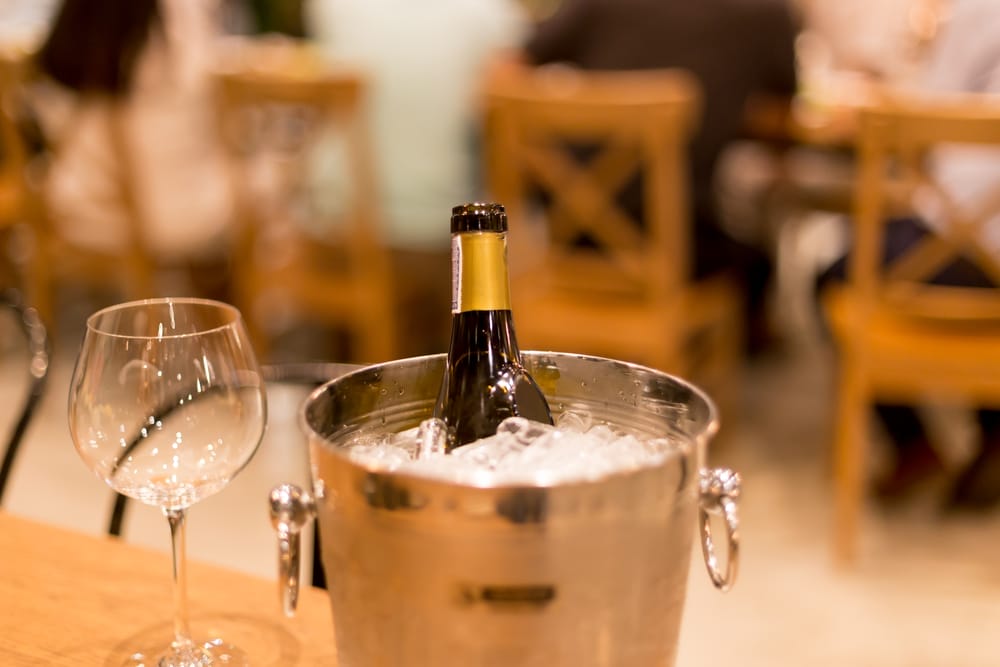If you’ve ever enjoyed a glass of white wine, you’ll surely have heard the common assertion that white wine is best served chilled. But is this really true?
In this article, we’ll break down the truth of this statement and find out whether white wine really does need to be chilled.
Along the way, we’ll discover the ideal temperatures for different varieties of white wine and uncover other expert insights. Whether you’re a regular drinker of white wine or only indulge occasionally, this guide will surely help to make your next glass perfect!
In this article, we’ll cover:
- The science of wine temperature
- General guidelines for white wine temperature
- Types of white wines and their ideal temperatures
- Chilling techniques and tips
- Serving white wine: beyond temperature
- Storing white wine: pre and post-chilling.
Let’s get started!

The Science of Wine Temperature
While white wine is commonly suggested to be best served chilled, how does this actually affect the flavor?
Interestingly, the colder the white wine, the more acidic, dry, and less sweet the wine will taste.
This is due to the cold temperatures inhibiting the release of compounds, which can make wines feel too watery when consumed.
In addition, if white wine is too cold, it will affect the ability of the individual to taste the flavors of the wine accurately.
General Guidelines for White Wine Temperature
So, what is the best temperature to store white wines in?
While it is true that white wines should be consumed at a temperature lower than that of red wines, you don’t want the white wine to be too cold.
The ideal temperature for chilling white wine is between 6 and 14 degrees celsius, or 43 and 57 degrees Fahrenheit.
Most refrigerators are set below 4 degrees Celsius, or 39.2 degrees Fahrenheit, so it’s easy to see how storing your white wine in the refrigerator can make it too cold!
It’s therefore not a good idea to serve your white straight from long-term storage in the refrigerator.
Types of White Wines and Their Ideal Temperatures

Now, let’s go over some more specific guidelines for optimal chilling temperatures for a range of different white wines:
Crisp and Light White Wines
Crisp and light white wines include varieties such as sauvignon blanc, and pinot gris. The following list specifies their ideal temperature for consumption.
As you can see, as these white wines are lighter, they can maintain their flavor in cooler temperatures:
- Sauvignon Blanc: 45-50°F (7-10°C)
- Pinot Grigio/Pinot Gris: 45-50°F (7-10°C)
- Riesling: 45-50°F (7-10°C)
- Chenin Blanc: 45-50°F (7-10°C)
- Albariño: 45-50°F (7-10°C).
Full-Bodied and Rich White Wines
Next let’s look at full-bodied and rich white wines, such as Chardonnay and Viognier.
These white wines generally need to be a bit warmer than their drier counterparts. The following is a breakdown of their ideal temperature for each variety:
- Chardonnay: 50-55°F (10-13°C)
- Viognier: 50-55°F (10-13°C)
- Semillon: 50-55°F (10-13°C)
- Muscat: 45-50°F (7-10°C)
- Gewürztraminer: 45-50°F (7-10°C).
Chilling Techniques and Tips
By now, you may be asking how you achieve the perfect temperature when chilling your wine! Let’s delve into some practical tips and methods for effectively chilling white wine:
Don’t store white wine in the refrigerator long term
Refrigerators are too cold for white wine. Instead store wine in cellars or another dark, dry place for longer storage
Place in the refrigerator for 2-3 hours before drinking
White wine only needs to be chilled for a short amount of time before drinking
If running low on time, place the white wine in the freezer for 20 – 25 minutes
This will bring the wine to the desired temperature – just don’t leave it in any longer than this!
Ice buckets can also work to bring the temperature down
Place white wine in a bucket or sink of cold water and ice before serving.
Common Mistakes to Avoid
While chilling your wine may seem straightforward, there are some common mistakes people tend to make. Let’s go over these briefly:
Refrigeration
Ensure you don’t refrigerate your wine for an extended period of time. White wine served at refrigerator temperatures will be too cold.
Ice Bucket
Ice Buckets also work to chill wine. Use a combination of ice and cold water, and wine will be chilled in approximately 15 minutes!
Freezer
If freezing your white wine, 20 – 25 minutes is sufficient. White wine left in longer than this is also at risk of exploding.
Wine sleeves or wraps
Wine sleeves are a great way to keep chilled wine cool – just don’t expect them to chill wine that is not already at the desired temperature.
Pre-Chill Glasses
If pre-chilling glasses for your wine, be careful that this doesn’t make your wine too cold overall. Generally, chilling glasses is not necessary if the wine is at the desired temperature.
Don’t Over-Chill
Whichever chilling method you use, it’s imperative not to over-chill! This will cause a loss of flavor in the wine and increase acidity.
Wine Buckets
If you’re at a gathering, a great way to keep wine chilled over a period of time is with ice buckets!
Serving White Wine: Beyond Temperature
Now that we’re clear on how to chill white wine, let’s go over some other factors you should consider when serving white wine including which glassware to use and whether or not you should use a decanter.
Glassware and Pouring
Wine glasses for white wine should be a medium size and should have a slightly curved shape. This allows the wine to maintain its fruity taste, aromas, and freshness.
The Role of Wine Decanting
Generally speaking, white wines don’t need to be decanted!
If you decide to decant white wine, do so straight before serving and don’t leave it decanted for a long period of time, as this will cause the wine to lose its aromas.
Storing White Wine: Pre and Post Chilling
Before we wrap up, let’s go over some additional tips on storing white wine before and after chilling:
Storing white wine after it has been opened
After you have opened white wine, you will need to store it in the refrigerator. Remember to take it out for a while to warm up when you wish to drink it
Store white wine horizontally
Storing wine horizontally ensures the cork remains moist and prevents it drying out
Maintain a consistent temperature (around 55°F or 13°C)
When storing wine, try to avoid too many temperature fluctuations which may alter the flavor of the wine over time
Keep wine away from direct sunlight and temperature fluctuations
When storing wine, keep it out of direct sunlight to prevent changes in temperature
Store bottles with natural cork in a slightly humid environment
Store bottles with corks in a more moist environment to prevent drying out
Use a wine cellar, wine fridge, or a cool, dark closet
Wine should be stored in a cool dark place such as a cellar or wine fridge
Avoid storing wine in the kitchen or on top of the refrigerator
Avoid storing wine in the kitchen if it will experience a lot of sunlight and temperature changes
Ensure bottles are sealed and corked properly
It’s imperative when storing wine once opened that the wine is fully sealed. If not, the wine will oxidize quickly.
Label and organize wines for easy retrieval
If you have a large wine collection, labeling and organizing your wine is a good idea and can assist in easy access when needed
Store wines with screw caps upright if needed
Wines with screw caps are fine to be stored upright if needed – this will not affect the flavor of the wine
Limit vibrations and disturbances in the storage area
Surprisingly, vibrations can create changes to the chemical compounds in the wine – changing the flavor and texture of the wine over time. Occasional bumps are fine, but do not store wine near appliances such as dishwashers or blenders.
Final Words
In summary, while wine should be chilled when served, it’s important that the temperature is not too cold!
Wine served straight from the refrigerator after a long period is definitely too chilly.
Instead, place your wine in the refrigerator for a maximum of 2 – 3 hours before drinking. If served too cold, this will cause your wine to become too acidic, watery and flavorless.
As we’ve seen, there are a myriad of different ways to chill your wine. It’s always fun to experiment with different methods to see which one you prefer!
- Moscato vs Roscato: A Comprehensive Comparison of Sweet Wines - December 15, 2023
- Should White Wine Be Chilled? Expert Insights on Serving Temperature - December 14, 2023
- Moscato vs Riesling: A Sweet Wine Showdown - December 8, 2023










